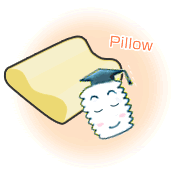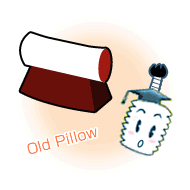
Episode 30: Body Aches and Pillows
Hello everyone. This makes “Springs and Technology” #30, a momentous occasion! Thanks for always reading. When we humans reach our 30s or 40s, our bodies start to ache here and there. Have you ever had a pain in your neck or shoulder and thought, “My pillow isn’t working for me”? You never even thought about your pillow when you were younger. So you go to the store and try a bunch of pillows, but, in the end, you can’t tell which you should get. Then someone working there sees you worrying and says sunnily, “The best pillows are the ones custom-made for your body type!” He’s trying to sell you on a custom-made pillow.
But it’s expensive, so you’re not sure. Then he tells you that, if you want a sure thing, you should get a memory foam pillow. The memory foam pillows are pretty expensive, too, but they’re not as expensive as the custom pillows, and your neck and shoulders do hurt, so you think, “Well, if it’ll take care of the pain…” and you give it a shot.

Memory foam is so named because it “remembers” its shape. It’s made of low-resilience polyurethane. You can drop a raw egg onto low-resilience polyurethane and it won’t crack. That’s because it absorbs the shock. There are also memory foam mattresses. When you roll over, a memory foam mattress slowly goes back to its original shape. So, low-resilience polyurethane takes shock with the power of elasticity and caves in slowly, and then it uses the same power of elasticity to slowly go back to its original shape. In other words, a memory foam pillow can also be considered a spring. In contrast, there is also something called high-resilience polyurethane. This has strong elastic force that makes it bounce back from shock right away. If you tried to plop down on high-resilience polyurethane, your head would bounce off like a volleyball or basketball on the floor. If you dropped an egg on high-resilience polyurethane, it would bounce and fly off somewhere. When you think of springs, you tend to think of bouncing, but springs can also be used to absorb shock, like low-resilience polyurethane. The weight of a person’s head depends on the person, but it’s usually about 5 kg. While a person is sleeping, the weight of their head is pushed back and supported by that low resilience. Apparently there are some people whose necks and shoulders get harmed from being pressed for a long time (when they’re sleeping). Then they go all out and order a custom-made pillow.

In the old days, it’s said, Japanese people slept on thin mattresses called “rice cracker mattresses.” Even longer ago, they slept on boards. They say sleeping on a hard surface is good for your digestive system. People sometimes use wooden pillows in period dramas. Apparently they’re high to keep their chonmage hairstyle in place, but didn’t they get sore necks? It looks like your neck would be crazy when you woke up.
Well, that’s all for today. Look forward to the next episode, #31! See you next time!
Written by Banekko (a child of spring)

